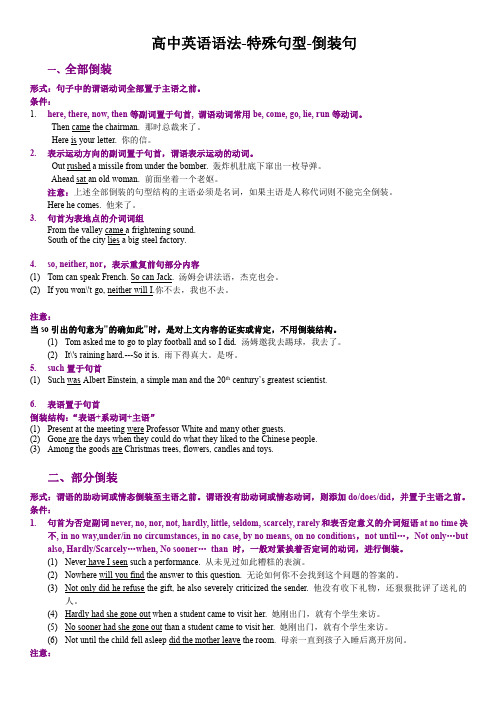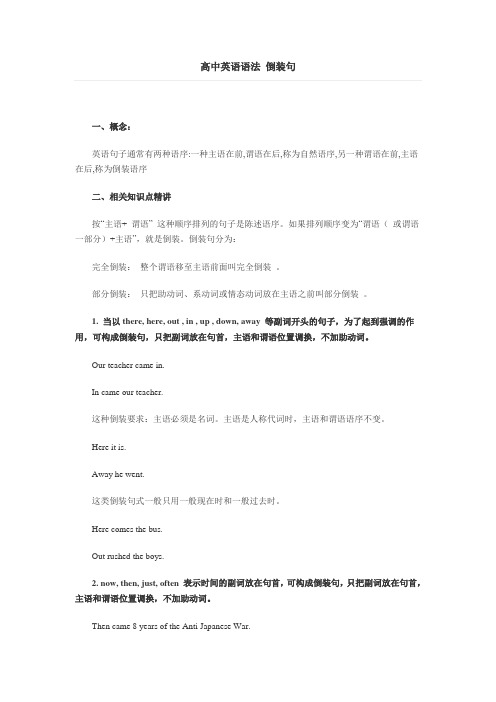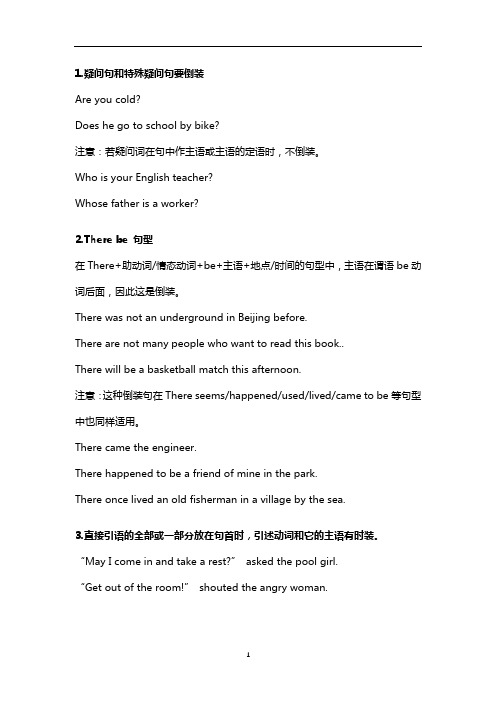高中英语语法_倒装句
高中英语语法-特殊句型-倒装句

高中英语语法-特殊句型-倒装句一、全部倒装形式:句子中的谓语动词全部置于主语之前。
条件:1.here,there,now,then等副词置于句首,谓语动词常用be,come,go,lie,run等动词。
Then came the chairman.那时总裁来了。
Here is your letter.你的信。
2.表示运动方向的副词置于句首,谓语表示运动的动词。
Out rushed a missile from under the bomber.轰炸机肚底下窜出一枚导弹。
Ahead sat an old woman.前面坐着一个老妪。
注意:上述全部倒装的句型结构的主语必须是名词,如果主语是人称代词则不能完全倒装。
Here he comes.他来了。
3.句首为表地点的介词词组From the valley came a frightening sound.South of the city lies a big steel factory.4.so,neither,nor,表示重复前句部分内容(1)Tom can speak French.So can Jack.汤姆会讲法语,杰克也会。
(2)If you won\'t go,neither will I.你不去,我也不去。
注意:当so引出的句意为"的确如此"时,是对上文内容的证实或肯定,不用倒装结构。
(1)Tom asked me to go to play football and so I did.汤姆邀我去踢球,我去了。
(2)It\'s raining hard.---So it is.雨下得真大。
是呀。
5.such置于句首(1)Such was Albert Einstein,a simple man and the20th century’s greatest scientist.6.表语置于句首倒装结构:“表语+系动词+主语”(1)Present at the meeting were Professor White and many other guests.(2)Gone are the days when they could do what they liked to the Chinese people.(3)Among the goods are Christmas trees,flowers,candles and toys.二、部分倒装形式:谓语的助动词或情态倒装至主语之前。
高中英语语法倒装句

1.His mother had talked to him for many minutes while he was watching TV, but ____. A. a little did he hear B. little did he hear C. little heard he D. a little heard he 2.—— Hello, Zhu Hua. I’ll have to return to Canada because I’ve worked here for a year. —— _____! What time flies B. How time flies C. What does time fly D. How does time fly 3. During the war, ____but also he lost his wife and his child. not was his job in the lab taken away B. not only was his job in the lab taken away C. not merely his job in the lab was taken away D. not just was taken away his job in the lab
C
D
11.— The old man wouldn’t stay at home for a rest even if it rained. — ____.He would feel sick if he stayed home for one day. A. So would my grandpa B. So wouldn’t my grandpa C. Neither would my grandpa D. Nor wouldn’t my grandpa 12.___for us to surf (冲浪) on the sea in summer! A. What exciting is it B. How exciting is it C. What exciting it is D. How exciting it is 13.By no means ___ to our plan for the trip. A. will she agree B. she will agree C. agrees she D. will agree she
(完整word)高中英语语法倒装句

高中英语语法倒装句一、概念:英语句子通常有两种语序:一种主语在前,谓语在后,称为自然语序,另一种谓语在前,主语在后,称为倒装语序二、相关知识点精讲按“主语+ 谓语” 这种顺序排列的句子是陈述语序。
如果排列顺序变为“谓语(或谓语一部分)+主语”,就是倒装。
倒装句分为:完全倒装:整个谓语移至主语前面叫完全倒装。
部分倒装:只把助动词、系动词或情态动词放在主语之前叫部分倒装。
1. 当以there, here, out , in , up , down, away 等副词开头的句子,为了起到强调的作用,可构成倒装句,只把副词放在句首,主语和谓语位置调换,不加助动词。
Our teacher came in.In came our teacher.这种倒装要求:主语必须是名词。
主语是人称代词时,主语和谓语语序不变。
Here it is.Away he went.这类倒装句式一般只用一般现在时和一般过去时。
Here comes the bus.Out rushed the boys.2. now, then, just, often 表示时间的副词放在句首,可构成倒装句,只把副词放在句首,主语和谓语位置调换,不加助动词。
Then came 8 years of the Anti Japanese War.3. 表地点状语的介词短语放在句首,要用倒装句式,以示强调。
这种倒装句也是主谓直接调换位置,不加助动词did, does或do.Under a big tree ________, half asleep.A. did sat a fat manB. a fat man satC. did a fat man satD. sat a fat man4. there放在句首时,要用倒装句式。
在“there + be”结构中的谓语动词有时不用be , 而用表示类似“存在”观念的其他不及物动词。
如:live, stand, come, lie, flow, enter, rise 和appear等。
高中英语语法之——倒装句

3于. s另o 一放人句;首,表示前面所说的情况也适用 He likes rice very well. So do I. He can ride a bike. So can I.
n也ei适th用er,于n另or一放人句.首,表示前面所说的情况 I have never been abroad. Neither has he. I didn’t read the notice on the blackboard, nor did he.
Hale Waihona Puke 部分倒装: 1.否定词或半否定词放句首时。 Never shall I forget it. Not a single mistake did he make. Not only was there no electricity, but also no water. 2 “only+状语” 位于句首时。 Only then did I realize that I was wrong. Only in this way can you learn from your friends. Only when the war was over in 1949 was he able to get back home.
全部倒装
1.
介词短语放句首,且谓语为不及物动词 的句子
On the wall hangs a map of China.
放2.句he首re,, th且er主e,语ou不t,是aw人ay称, u代p,词d的ow句n等子副。词 Here comes the bus. There goes the bell. Out rushed the children. Away went the boy.
高中英语语法——倒装句总结

一、倒装句的定义主语和谓语是句子的核心,它们之间有两种语序:一是主语在谓语之前称为自然语序(Natural Order)/陈述语序;二是主语在谓语之后则称为倒装语序(Inverted Order)。
为了强调、突出等语的目的而颠倒原有语序的句式叫做倒装句。
在倒装句中,颠倒了的成分可以恢复原位而句意基本不变,句法成分不变。
中文例子:还行吧这样可以吧我觉得我认识他好像想啥呢刚才吃饭了嘛你可以的他倒装句可分为全部倒装和部分倒装两种:1、全部倒装谓语动词提前至主语之前为全部倒装。
a.用于there be 句型. There is a bus comingb. 用于“ here (there, now, then )+不及物动词+主语”的句型中,或以in, out, up, down, away 等副词开头的句子里,以表示强调.注意:(1 )主语是代词时,主语和谓语不倒装.(2 )here , there 放在句首通常用一般现在时. There comes the bus.c. 当句首状语为表示地点的介词词组.d. 表语置于句首时,倒装结构为“表语+连系动词+主语”:(1 )形容词+连系动词+主语Present at the meeting were Mr Li, Mr Wang and many other teachers.Mr Li, Mr Wang and many other teachers were present at the meeting出席会议的有李老师、王老师和其他很多老师.(2 )过去分词+连系动词+主语Gone are the days when we used foreign oil.The days when we used foreign oil are gone.The days are gone when we used foreign oil.我们使用洋油的日子一去不复返了.(3 )介词短语+be +主语Among the goods are books, exercise-books, pens and some other things.在所有的货物中有书、练习册、钢笔和其他东西.e. 用于so, neither , nor 开头的句子,表示重复前句的部分内容.原句的谓语应与前句的谓语的时态、形式相一致.S he can’t speak French neither. Neither can she speak French.You are a good student. 他也是。
高三英语语法讲解----倒装句

主句
从句
I did not know the truth until I saw the pistachio nuts.
Not until I saw the pistachio nuts did I know the truth.
until从句不倒装
not主句半倒装(一般疑问பைடு நூலகம்构)
Page 17
二、部分倒装
Page 15
二、部分倒装
部分倒装:将谓语动词的一部分(助动词/系动词/情态动词)置于主语前 情况1:当否定词或者带有否定意义的词或短语位于句首时 【学以致用】
I seldom arrange homework to students. Seldom do I arrange homework to students
他冲出去了
Out he rushed.
注意: 如果主语为人称代词,则不需要倒装。
Page 10
一、全部倒装
全部倒装:全部谓语放在主语之前 情况2:地点方位介词置于句首时 如on the wall, under the tree, in front of the house, in the middle of the room等
部分倒装:将谓语动词的一部分(助动词/系动词/情态动词)置于主语前 情况1:当否定词或者带有否定意义的词或短语位于句首时 特殊用法2:not only…but also【前倒后不倒】 My brother not only cheated me out of my money but also insulted my intelligence. Not only did my brother cheat me out of my money but also insulted my intelligence. 但not only...but also...连接主语时,不倒装。 Not only the mother but also the children are sick. 特殊用法3:“一……就……”句型的倒装 Hardly/Scarcely/Barely had + 主语 + done when + 主 + 谓 Hardly had he sworn to god when it thundered. No sooner had + 主语 + done than 主 + 谓 No sooner had he sworn to god than it thundered.
高中英语语法——倒装句

倒装句倒装的原因:①语法原因②强调③平衡句子结构④承上启下完全倒装:整个谓语都在主语之前。
部分倒装:助动词/be/情态动词等放在主语之前。
一、完全倒装:整个谓语都在主语之前1. there be句型(特殊的全部倒装句型):其中be可换为appear, come,exist, happen,lie,live,stand等动词。
[exist/iɡ'zɪst/ vi.存在;生存]There is an experienced teacher and many lovely students in the classroom. 教室里有一位经验丰富的老师和许多可爱的学生。
There stands a temple on the top ofthe mountain. 山顶上有座庙。
2. 将here, there, now, then等地点或时间副词置于句首,且谓语动词是be, come, go, remain, lie, run等,且主语为名词时,用完全倒装。
—Is everyone here? 每个人都在这儿吗?—Not yet ... Look, there come the rest of our guests! 还没有。
看,其余的客人来了。
Here comes my list of dos and don’ts:... 下面是我的行为准则:...Here is some advice for you to follow while listening to his lecture.下面是你听他的报告时可以遵循的一些建议。
3. 表示运动方向的副词out, in, up, down, away等置于句首,谓语是表示运动的动词,且主语为名词时,句子要用完全倒装。
In the dark corner of the room, up jumped the cat and caught the mouse. 在房间黑暗的角落里,那只猫跳了上去并抓住了那只老鼠。
高考英语语法---倒装句常见的几种类型+经典例句

1.疑问句和特殊疑问句要倒装Are you cold?Does he go to school by bike?注意:若疑问词在句中作主语或主语的定语时,不倒装。
Who is your English teacher?Whose father is a worker?2.There be 句型在There+助动词/情态动词+be+主语+地点/时间的句型中,主语在谓语be动词后面,因此这是倒装。
There was not an underground in Beijing before.There are not many people who want to read this book..There will be a basketball match this afternoon.注意:这种倒装句在There seems/happened/used/lived/came to be等句型中也同样适用。
There came the engineer.There happened to be a friend of mine in the park.There once lived an old fisherman in a village by the sea.3.直接引语的全部或一部分放在句首时,引述动词和它的主语有时装。
“May I come in and take a rest?”asked the pool girl.“Get out of the room!”shouted the angry woman.4.以here, there, now, in ,out, up, down, away, then等副词开头的句子中,句子要倒装,以示强调。
习惯上,除以then开头的句子用过去时外,其余一般使用现在时。
There goes the bell.铃声响了。
There comes the bus! 汽车来了。
- 1、下载文档前请自行甄别文档内容的完整性,平台不提供额外的编辑、内容补充、找答案等附加服务。
- 2、"仅部分预览"的文档,不可在线预览部分如存在完整性等问题,可反馈申请退款(可完整预览的文档不适用该条件!)。
- 3、如文档侵犯您的权益,请联系客服反馈,我们会尽快为您处理(人工客服工作时间:9:00-18:30)。
英语倒装句分为两种:
1、整个谓语在主语前的句子,叫完全倒装。
In came our English teacher.
There is a table in the room.
2、部分谓语(情态动词、主动词、连系动词)在前,谓语的主体部分仍在主语之后的句子,叫不完全倒装句/部分倒装。
Why did you do it like that?
Seldom have I been to Beijing.
一、完全倒装
1. There be 句型
there be 句子中,谓语是be, exist, live, lie 等表示状态的不及物动词。
动词后的名词为句子的主语。
句子的谓语应与最靠近它的主语相一致
There is nobody in the classroom.
There seems something wrong with my radio.
There happened an event last week.
There stands a temple on the top of the mountain.
2. 用于方位副词(here、there、now、out、in、then、up、down、away、over、off、back 等)开头的句子中。
Look, here comes the bus!
Out went the children.
The door opened and in came Mr. Smith, our headmaster.
Tips:
①当代词做句子的主语时,句子不能倒装。
②进行时不用于倒装!
Away they went. Back they fought.
Here he comes. Up it flew.
3. 方位介词短语位于句首时
On the top of the hill lies an old temple.
4. “分词+be+主语”
Walking at the head of the line was our teacher
Gone are the days when the Chinese people used foreign oil
Hanging on the wall was a clock made in Germany.
5. Such +be +主语
Such is what he said.
Such are his words
二、不完全倒装/部分倒装
1. 句首状语为否定词或半否定词的句子。
never, neither, nor, little, seldom, rarely, hardly, scarcely, no sooner, not only, in no way, at no time, few, not, no等
Never have I found him so happy.
Little does he care about his clothing
2. only + 状语放在句首,要部分倒装。
Only by this means is it possible to explain it.
Only then did I realize the importance of math.
Only when the war was over did he go back home
3. “Not only + 分句,but also + 分句”句型中的前一分句需要部分倒装
Not only does John love Chinese, he is also good at speaking it.
Not only are the students planting trees, but also the teacher is.
4. Not until放在句首,从句不倒装,主句倒装。
Not until last week did they find the lost bike
5. So……that 从句不倒装,主句部分倒装。
So suddenly did he catch the disease that the whole family were at a great loss
6. No sooner……than; Hardly……when; Scarcely ……when
No sooner had he gone out than he fell down
7.as引导的让步状语从句。
①. Child as he is, he knows a lot
②. Hardworking as he was, he failed to pass the test again
③. Try as he might, he failed again
④. Hard as he works, he earns little.
8. so 表示“也一样”,neither,nor 表示“也不”,放在句首..
I saw the film, so did she.
He hasn’t been to Beijing, neither have I.
Tom doesn’t like fish, nor do I
9 虚拟语气里面的倒装
虚拟语气if 从句中出现were /should/ had可以将这几个词提前到从句之前,if 去掉。
